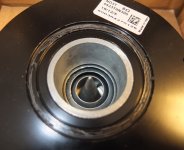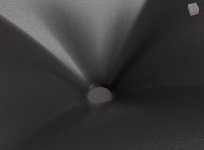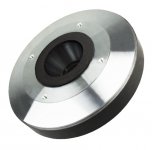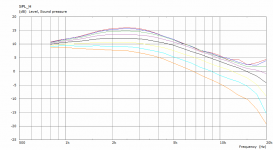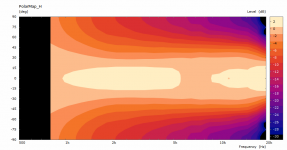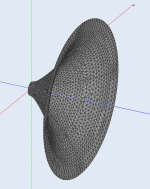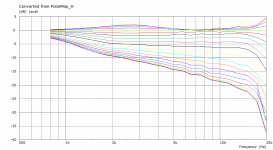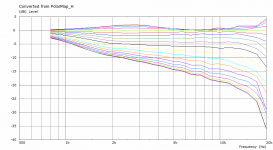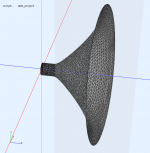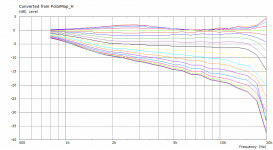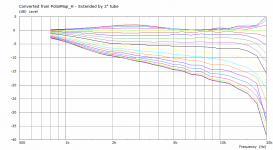Of course not, these drivers are quite different. Changing the entry angle is only a small modification in the process, takes very little effort to change it to any value. All other dimensions stay exactly the same.Same entrance angle for both drivers?
The price will depend on how good they turn out to be 🙂
Of course not, these drivers are quite different. Changing the entry angle is only a small modification in the process, takes very little effort to change it to any value. All other dimensions stay exactly the same.
The price will depend on how good they turn out to be 🙂
It would be interesting to see the plots of both drivers with swapped waveguides.
I wouldn't be surprised if the differences prove to be marginal.
Well, I would be surprised if there wasn't an appreciable difference. Maybe not on both but the BMS 4554 has about 27° exit angle. Connecting this to 9° of the ND3T should be noticeable and detrimental, IMHO. I'm only not sure it will be possible to try.
T
But IMO the audibility of horn distortion is relevant to the goal of this 'design project' thread. Do the designers ignore it as being unimportant (Dr Geddes), or do they set a target and meet it
I just want to clear up this misinformation before it gets propagated. I know that I have said this many times, but I still read things like this so there is obviously a great deal of misunderstanding.
1) nonlinearity does matter, but not all nonlinearity are equally audible. We need to understand what actually matters and what doesn't. So setting a target is fine as long as it is meaningful.
2) THD and IMD are NOT meaningful because they do not correlate with perception. Of course one can always find cases where they are but there are just as many where they are not. How does one know which one we have? If one set of THD and IMD measures can be shown to be wrong, then the whole idea of them is wrong.
3) good metrics do exist and according to those, nonlinearity in most loudspeakers played within their design constraints is NOT an appreciable problem. They can be in electronics as crossover distortion shows.
Sorry, it was talked few posts above, but not sure I understood there are real conclusions about that :
Are enclosure and mouth edges difractions irrevelant with horns > 400 mm, please ? Or is it still prudent to make something smoother at mouth edges, sides or top, for the mouth not seing a 90° angle ? - no round bump on the low side of the mouth because bafle transition with another horn or a dynamic driver.
Phrased diferently: better a cabinet a little less width that these horns if flat transition not a problem: better to see recessed cabinet than a flat plan on sides ?
Are enclosure and mouth edges difractions irrevelant with horns > 400 mm, please ? Or is it still prudent to make something smoother at mouth edges, sides or top, for the mouth not seing a 90° angle ? - no round bump on the low side of the mouth because bafle transition with another horn or a dynamic driver.
Phrased diferently: better a cabinet a little less width that these horns if flat transition not a problem: better to see recessed cabinet than a flat plan on sides ?
Last edited:
I don't know the answer myself. If you wait a while, it will be possible to simulate this easily - with Gmsh library it's a matter of a few lines of code to put a waveguide in a (rounded) box or even a sphere.
It's more a theorical question, frankly : no hurge at all, as a perpetual noob - but for listening music- I'm traveling light between theories, personal else's hifi listening, trade offs with the rooms and more - and always balancing between trade offs and choices for the main loudspeaker system I could resume like that : sota horn(s) high dynamic system -knowing the reccordings are more and more craps on the dynamic range side- and ESL 63 or Martin Logan. Aside, sound reproduction theory, knowledge, is a real involvment... as some for cars, watches, furnitures, etc, dark your case here.
I'm admirative about your work in several domain, sound, coding, and also some of you here in the thread. Simply dream to have to choose between two good enough systems : a 2 ways with horn listenable at 3 meters-cut-off something 800 hz for a good 15" and I know 3 ways are easier here traditionally- or an ESL despite the trade offs. Really : listening rooms sucks and make choice very difficult imho.
keep the good work, really a joy to read 🙂
I'm admirative about your work in several domain, sound, coding, and also some of you here in the thread. Simply dream to have to choose between two good enough systems : a 2 ways with horn listenable at 3 meters-cut-off something 800 hz for a good 15" and I know 3 ways are easier here traditionally- or an ESL despite the trade offs. Really : listening rooms sucks and make choice very difficult imho.
keep the good work, really a joy to read 🙂
Last edited:
Well, I would be surprised if there wasn't an appreciable difference. Maybe not on both but the BMS 4554 has about 27° exit angle. Connecting this to 9° of the ND3T should be noticeable and detrimental, IMHO. I'm only not sure it will be possible to try.
My mistake, I confused the ND3T with the ND4015 series that lack a conical exit section.
Attachments
Last edited:
The ND3T wouldn't be my first choice to use with a waveguide.
As for top octave dispersion, you'd probably be better off using a 3" diaphragm driver with 2" wide angle exit,
like this one (36° Conical):
As for top octave dispersion, you'd probably be better off using a 3" diaphragm driver with 2" wide angle exit,
like this one (36° Conical):
Attachments
Last edited:
I do not like the idea of developing a horn that only works with a certain driver. My experience is that even if dispersion is really important, it does not over rule the fact that most drivers are quite large compromizes.
ATH4 horns can be adapted to almost any driver('s exit).
My comment regarding the ND3T is just an assumption, measurements will show whether it is correct.
It seems most 18Sound compression drivers are developed for:
- Tractrix-like horns (XT1086, XT1464)
- Optimized diffraction horns (XR-series)
- Narrow beam array applications (XG-series).
Every driver and therefore every loudspeaker system is a compromise of sorts.
My comment regarding the ND3T is just an assumption, measurements will show whether it is correct.
It seems most 18Sound compression drivers are developed for:
- Tractrix-like horns (XT1086, XT1464)
- Optimized diffraction horns (XR-series)
- Narrow beam array applications (XG-series).
Every driver and therefore every loudspeaker system is a compromise of sorts.
Last edited:
I always wonder what assumptions lead you to these "conclusions" (or assumptions). Would you care to explain the rationale?It seems most 18Sound compression drivers are developed for:
- Tractrix-like horns (XT1086, XT1464)
- Optimized diffraction horns (XR-series)
- Narrow beam array applications (XG-series).
But I wanted to show something different - I extended the above WG by an 1" of a tube, driven by a plane wave (as before - throat angle is 0).
There is now a reflection, but the directivity is virtually unchanged. Some might have thought that the tube will beam by itself on high frequencies - that is not the case. It doesn't matter what's the "history" of the wavefront at the throat. In this case it's still just a plane wave as before.
There is now a reflection, but the directivity is virtually unchanged. Some might have thought that the tube will beam by itself on high frequencies - that is not the case. It doesn't matter what's the "history" of the wavefront at the throat. In this case it's still just a plane wave as before.
Attachments
Last edited:
I always wonder what assumptions lead you to these "conclusions" (or assumptions). Would you care to explain the rationale?
In this regard it's pretty obvious: intended use.
Most manufacturers produce drivers for the purposes (needs) of their (prospected) clients.
The accessories (horns) reflect these needs. From the range of accessories it can be concluded that the majority of 18Sound's customers use the drivers for 2 or 3 way top / install speakers and line-arrays.
The horns are not exactly of the waveguide type, i.e. none of those features a rapid flare rate from the driver into the horn, perhaps with the exception of the XT1086.
One might argue, FaitalPro only sells Tractrix horns and yet some of their drivers (2") have a wide exit angle. Exceptions exist and these drivers were measured (and intended for use(?)) with non-Faital horns, presumably 2380 (derivatives), which happen to feature a surprisingly wide entry angle.
The throatless 18Sound 4015 drivers seem suitable for an (OS) waveguide at first glance, but I'm afraid they'll run out of steam in the top octave.
Last edited:
I'm quite convinced that manufacturers don't match thier compression drivers to any particular horn, not even their own. For example B&C even admits this openly - that most of the customers use their own horns anyway. So I'd say that the "simple" universal goal is just to have a coherent plane wave at the exit of the driver, in whatever horn will be used. That's my impression.
Make it 2 inches (original on the left, extended by a tube on the right) -... I extended the above WG by an 1" of a tube, driven by a plane wave
Attachments
What is beneficial is when the wavefront is already curved at the entrance of the waveguide for the same throat diameter (i.e. in the case of a higher exit angle of a driver of the same exit size, as for 4554 vs ND3T). I'd be not so sure that a higher exit angle in a bigger throat would still be better - this could be verified as well. Anyone can do it.
Last edited:
- Home
- Loudspeakers
- Multi-Way
- Acoustic Horn Design – The Easy Way (Ath4)
